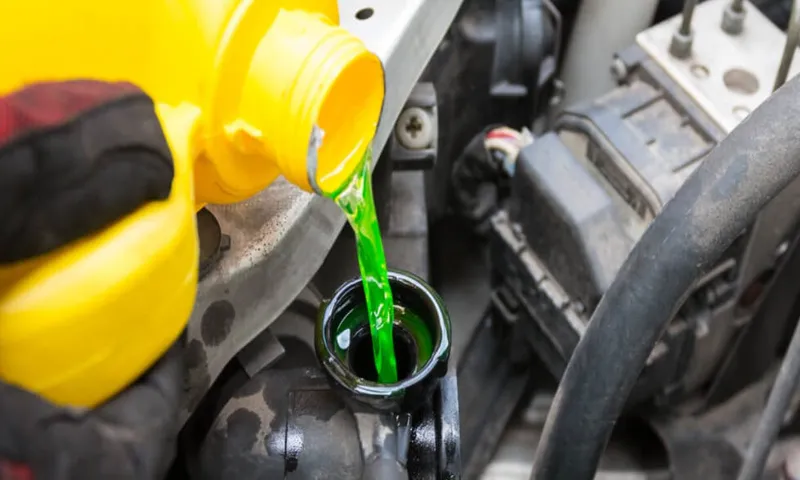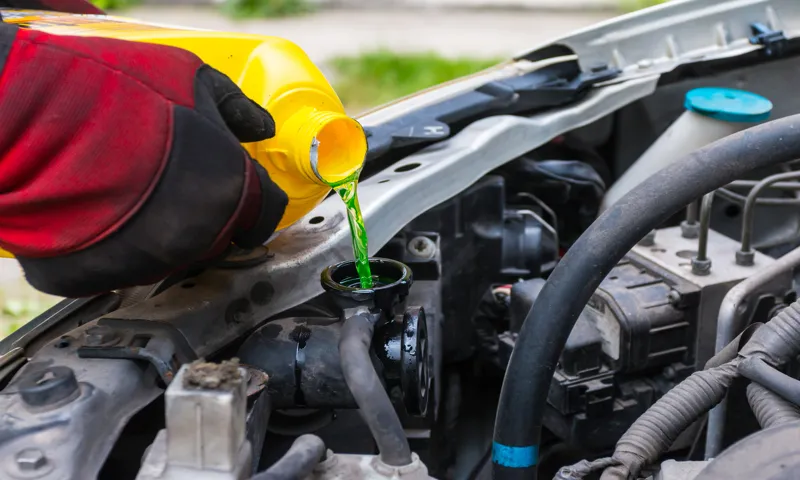When it comes to car maintenance, there are some tasks that can easily slip our minds. One of those tasks is a coolant flush. But what exactly is a coolant flush? And why is it important for the health of your vehicle? Think of your car’s cooling system as its own personal air conditioning system.
Just like your AC needs a refrigerant to keep you cool, your car’s cooling system needs coolant to regulate its temperature. The coolant helps to absorb excess heat from the engine and dissipate it, preventing the engine from overheating. But over time, that coolant can become contaminated with dirt, debris, and rust particles.
This can lead to a decrease in its effectiveness and potentially cause damage to your engine. So, a coolant flush is essentially the process of draining out the old coolant and replacing it with fresh, clean coolant. It’s like giving your car’s cooling system a much-needed spa day.
During a coolant flush, a technician will drain the old coolant from the radiator and engine block, flush out any residue, and then refill the system with new coolant. But why is a coolant flush necessary? Well, think of it this way: if you go too long without changing the oil in your car, it can become dirty and lose its ability to lubricate the engine properly. The same goes for coolant.
Over time, it can become contaminated and lose its ability to effectively cool your engine. This can lead to overheating, which can cause serious damage to your car’s engine. By getting a coolant flush on a regular basis, you can ensure that your car’s cooling system stays in tip-top shape.
Not only will it help prevent overheating, but it can also extend the life of your engine and save you from costly repairs down the road. So, the next time you’re scheduling your car’s maintenance, don’t forget to include a coolant flush. It may not be the most glamorous task, but it’s an essential one for keeping your car running smoothly and avoiding any unexpected breakdowns.
Table of Contents
Introduction
So, you’ve probably heard the term “coolant flush” thrown around at the mechanic shop, but what exactly does it mean? Well, a coolant flush is a maintenance procedure that involves draining the old coolant from your car’s cooling system and replacing it with fresh coolant. The cooling system is responsible for keeping your car’s engine at the optimal temperature, and the coolant plays a vital role in this process. Over time, the coolant can become contaminated with rust, dirt, and other debris, which can hinder its ability to do its job effectively.
That’s where a coolant flush comes in. By flushing out the old coolant and replacing it with a clean batch, you’re ensuring that your engine stays cool and runs smoothly. It’s a bit like giving your car a refreshing drink to keep it hydrated and performing at its best.
So, the next time your mechanic suggests a coolant flush, remember that it’s all about keeping your engine cool and preventing any overheating issues.
Definition of Coolant Flush
coolant flush

Importance of Coolant Flush
coolant flush
Process of Coolant Flush
A coolant flush is a crucial maintenance procedure for your vehicle’s cooling system. The cooling system consists of various components, including the radiator, water pump, and thermostat, all working together to regulate the engine’s temperature. Over time, coolant can become contaminated with dirt, debris, and rust, which can hinder its ability to effectively cool the engine.
A coolant flush involves draining the old coolant from the system and replacing it with fresh coolant. This process helps remove any accumulated contaminants and ensures proper cooling performance. It is recommended to have a coolant flush performed every 30,000 to 50,000 miles, depending on your vehicle’s make and model.
Furthermore, it is also important to use the correct type of coolant specified by the manufacturer to prevent any potential damage to the cooling system. So, if you want to keep your engine running cool and prevent overheating issues, a coolant flush is definitely a maintenance procedure worth considering.
Draining the Old Coolant
coolant flush, old coolant, draining coolant, process of coolant flush
Flushing the Cooling System
coolant flush, flushing the cooling system
Refilling with New Coolant
coolant flush, refilling coolant, new coolant, process of coolant flush If it’s been a while since you last had your coolant flushed, it might be time to consider performing this important maintenance task. A coolant flush involves completely draining the old coolant from your system and replacing it with fresh coolant. This process helps to remove any contaminants or debris that may have built up over time, ensuring optimal performance and longevity for your engine.
To begin the coolant flush process, make sure your engine is cool and locate the radiator drain plug. Once you’ve located the drain plug, place a drain pan underneath to catch the old coolant as it drains out. Carefully open the drain plug and allow the old coolant to fully drain.
Once all the old coolant has been drained, close the drain plug and move on to the next step. Now it’s time to refill your system with new coolant. Start by locating the radiator fill cap and removing it.
Slowly pour in the recommended type and amount of coolant, being careful not to spill. Once you’ve added enough coolant, replace the fill cap and start your engine. Allow the engine to run for a few minutes to circulate the new coolant throughout the system.
Afterward, check the coolant level and top it off as needed. And that’s it! You’ve successfully flushed and refilled your coolant system. Remember to follow your vehicle manufacturer’s recommendations for how often this maintenance task should be performed to keep your engine running smoothly.
Signs that You Need a Coolant Flush
A coolant flush is a process that involves removing the old coolant from your vehicle’s cooling system and replacing it with fresh coolant. Over time, coolant can become contaminated with dirt, rust, and other debris, which can affect its performance and potentially cause damage to your engine. So how do you know if you need a coolant flush? Well, there are a few signs to look out for.
If you notice that your engine is running hotter than usual or that your vehicle’s temperature gauge is consistently higher than normal, it could be a sign that your coolant is not circulating properly. Another indicator is if you see coolant leaking from your vehicle or if you notice a sweet smell coming from under the hood. These are all signs that your cooling system may be in need of a flush.
It’s important to address these issues promptly to prevent any further damage to your engine and to ensure that your vehicle stays running smoothly. So if you’re experiencing any of these symptoms, it may be time to schedule a coolant flush for your car.
Overheating Engine
One of the biggest signs that your car’s engine may be overheating is if you notice that the temperature gauge is consistently running in the red zone. This is a telltale sign that something is wrong with your cooling system and that your engine is not being properly cooled. Another sign to watch out for is if you start to notice a strong smell of burning coolant or if you see smoke coming from under the hood.
This could be an indication that your coolant is leaking or that it is not circulating properly throughout the engine. Additionally, if you find that your car is constantly running hot, even if you are not seeing any visible signs of overheating, it may be a good idea to have your cooling system checked. Regular maintenance, including having a coolant flush every couple of years, can help prevent your engine from overheating and extend the life of your vehicle.
So if you’re experiencing any of these signs, it’s time to take your car to the mechanic and get a coolant flush. Don’t wait until it’s too late and you’re stranded on the side of the road with a smoking engine.
Rusty or Dirty Coolant
signs that you need a coolant flush.
Benefits of Coolant Flush
A coolant flush is a maintenance procedure that involves draining the old coolant from your vehicle’s cooling system and replacing it with fresh coolant. This process helps to keep your engine running at the optimal temperature and prevents overheating. Coolant, also known as antifreeze, is a vital component of your vehicle’s cooling system as it helps to regulate the temperature and prevent corrosion and freezing.
Over time, the coolant can become contaminated with dirt, rust, and other debris, which can hinder its ability to effectively cool the engine. By flushing the coolant, you not only remove these impurities but also ensure that the coolant is in good condition and can continue to provide proper cooling. Regular coolant flushes can extend the lifespan of your engine and prevent costly repairs down the line.
So, if you want to keep your engine running smoothly, a coolant flush is definitely worth considering.
Prevents Engine Damage
coolant flush, engine damage, coolant system, engine cooling, radiator, antifreeze, coolant exchange, coolant level, car engine, overheating, maintenance A coolant flush is a crucial part of regular car maintenance that can greatly benefit the overall health of your vehicle’s engine. The coolant system in your car is responsible for keeping your engine cool and preventing it from overheating. Over time, the coolant in your system can become contaminated with debris, dirt, and rust, which can hinder its ability to effectively cool your engine.
This can lead to engine damage and costly repairs if left unchecked. By getting a coolant flush, you remove the old coolant from your system and replace it with fresh coolant. This helps to maintain the proper coolant level and ensures that your engine is receiving the cooling it needs.
Coolant flushes also allow for the inspection and cleaning of the radiator and other components of the cooling system, which can help identify any potential issues before they become major problems. Regular coolant flushes can help prevent engine damage by keeping the coolant system in optimal condition. When your engine is properly cooled, it runs more efficiently and experiences less stress, reducing the risk of overheating.
Overheating can lead to serious damage to the engine, such as warped cylinder heads, blown gaskets, or even a complete engine failure. Additionally, a coolant flush can help remove harmful contaminants from the system, such as dirt and rust, which can clog up the radiator and other components. This can improve the overall performance of your engine and extend its lifespan.
In summary, a coolant flush is an essential part of car maintenance that can prevent engine damage and keep your engine running smoothly. By removing old coolant and replacing it with fresh coolant, you can ensure that your engine receives the cooling it needs. Regular coolant flushes can also help identify and address any potential issues before they become major problems.
So, don’t overlook the importance of this simple yet effective maintenance task in keeping your car’s engine in top shape.
Improves Cooling System Efficiency
coolant flush, cooling system efficiency
Extends the Life of the Engine
coolant flush, extend engine life, benefits of coolant flush When it comes to taking care of our vehicles, we often forget about some of the smaller, yet equally important, maintenance tasks. One of these tasks is getting a coolant flush. Now, you might be thinking, “Why do I need a coolant flush? What’s the benefit?” Well, let me tell you, getting a coolant flush can actually extend the life of your engine! You see, over time, coolant can become contaminated with debris, rust, and other harmful substances that can clog up your engine and cause it to overheat.
This can lead to serious damage and, ultimately, a shorter lifespan for your engine. By getting a coolant flush, you are essentially flushing out all of these contaminants and replacing the old coolant with fresh, clean coolant. This ensures that your engine stays cool and lubricated, reducing the risk of overheating and prolonging its life.
Think of it like this: just like you need to drink plenty of water to stay hydrated and keep your body running smoothly, your engine needs clean coolant to stay cool and prevent damage. Would you want to drink dirty, contaminated water? Of course not! So why would you want your engine to run on dirty, contaminated coolant? By getting a coolant flush, you are giving your engine the clean, fresh coolant it needs to keep running at its best. Not only will this extend the life of your engine, but it will also improve its performance and fuel efficiency.
So, the next time you’re due for some routine maintenance on your vehicle, don’t forget about the importance of a coolant flush. Your engine will thank you!
Conclusion
A coolant flush is like a spa day for your car’s cooling system. Just like how you need a deep cleansing facial to remove dirt and impurities from your skin, your car’s engine needs a coolant flush to rid itself of built-up debris and contaminants. It’s like pressing the reset button on your car’s internal thermostat, ensuring that it stays cool and collected even in the hottest of situations.
So, next time your car is feeling a little hot under the hood, treat it to a coolant flush and watch as it cools down and revives itself, ready to hit the roads with a refreshing confidence. After all, a little pampering goes a long way, even for our four-wheeled friends!”
FAQs
What is a coolant flush?
A coolant flush is a maintenance procedure performed on a vehicle’s cooling system to remove old coolant and debris, and replace it with fresh coolant.
How often should I get a coolant flush?
It is generally recommended to get a coolant flush every 40,000 to 100,000 miles, or every 2 to 5 years, depending on the manufacturer’s recommendations for your specific vehicle.
Why is a coolant flush necessary?
A coolant flush is necessary to maintain the proper functioning of a vehicle’s cooling system. Over time, coolant can become contaminated with rust, debris, and other contaminants, which can lead to overheating and engine damage if not flushed regularly.
What are the signs that indicate I need a coolant flush?
Signs that indicate you may need a coolant flush include overheating, a sweet smell coming from the engine, coolant leaks, and discolored or dirty coolant.
Can I do a coolant flush myself, or should I take it to a professional?
While it is possible to do a coolant flush yourself, it is recommended to have it done by a professional technician. This ensures that the procedure is done correctly, and any other underlying issues can be identified and addressed.
How long does a coolant flush typically take?
The time it takes to perform a coolant flush can vary depending on the vehicle make and model, but on average, it can take around 1 to 2 hours.
What happens if I don’t get a coolant flush?
If you don’t get a coolant flush when needed, your vehicle’s cooling system can become clogged with debris and contaminants, leading to overheating, engine damage, and potentially costly repairs.
How much does a coolant flush typically cost? A8. The cost of a coolant flush can vary depending on factors such as the vehicle make and model, location, and the service provider. On average, you can expect to pay between $100 to $200 for a coolant flush.
Can a coolant flush improve my vehicle’s performance?
Yes, a coolant flush can improve your vehicle’s performance by ensuring that the cooling system is clean and functioning properly. This helps prevent overheating, engine damage, and other issues that can negatively impact performance.
Can I use any type of coolant for a flush, or are there specific coolant types to use?
It is important to use the recommended coolant type for your specific vehicle, as specified in the owner’s manual. Using the wrong type of coolant can lead to damage to the cooling system. It is best to consult with a professional technician to determine the correct coolant for your vehicle.
Can a coolant flush fix a coolant leak?
A coolant flush alone cannot fix a coolant leak. If you have a coolant leak, it is important to have it identified and repaired by a professional technician.
Is a coolant flush the same as a radiator flush?
While the terms coolant flush and radiator flush are often used interchangeably, a coolant flush typically includes flushing the entire cooling system, including the radiator, whereas a radiator flush specifically focuses on cleaning the radiator.


